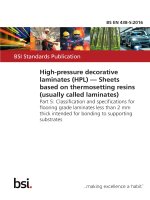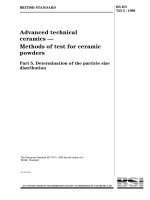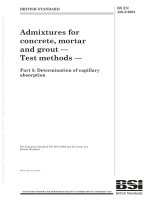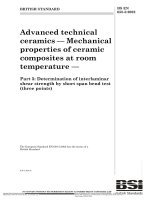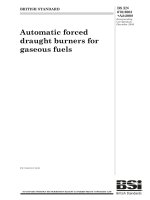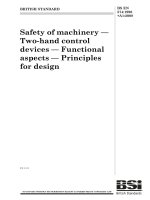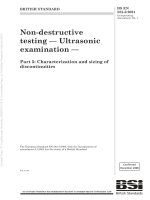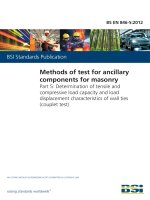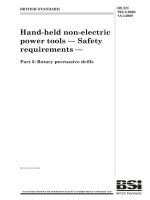Bsi bs en 61158 5 16 2008
Bạn đang xem bản rút gọn của tài liệu. Xem và tải ngay bản đầy đủ của tài liệu tại đây (353.19 KB, 36 trang )
BS EN 61158-5-16:2008
BSI British Standards
Industrial communication
networks — Fieldbus
specifications —
Part 5-16: Application layer service
definition — Type 16 elements
NO COPYING WITHOUT BSI PERMISSION EXCEPT AS PERMITTED BY COPYRIGHT LAW
raising standards worldwide™
BRITISH STANDARD
BS EN 61158-5-16:2008
National foreword
This British Standard is the UK implementation of EN 61158-5-16:2008. It is
identical with IEC 61158-5-16:2007. Together with all of the other sections of
BS EN 61158-5, it supersedes BS EN 61158-5:2004 which is withdrawn.
The UK participation in its preparation was entrusted to Technical Committee
AMT/7, Industrial communications - Process measurement and control,
including Fieldbus
A list of organizations represented on this committee can be obtained on
request to its secretary.
This publication does not purport to include all the necessary provisions of a
contract. Users are responsible for its correct application.
Compliance with a British Standard cannot confer immunity from
legal obligations.
This British Standard was published under the authority of the Standards
Policy and Strategy Committee on 31 January 2009.
© BSI 2009
ISBN 978 0 580 61601 3
ICS 25.040.40; 35.100.70
Amendments issued since publication
Amd. No.
Date
Text affected
BS EN 61158-5-16:2008
EUROPEAN STANDARD
EN 61158-5-16
NORME EUROPÉENNE
March 2008
EUROPÄISCHE NORM
ICS 35.100.70; 25.040.40
Partially supersedes EN 61158-5:2004 and EN 61491:1998
English version
Industrial communication networks Fieldbus specifications Part 5-16: Application layer service definition Type 16 elements
(IEC 61158-5-16:2007)
Réseaux de communication industriels Spécifications des bus de terrain Partie 5-16: Définition des services
des couches d'application Eléments de type 16
(CEI 61158-5-16:2007)
Industrielle Kommunikationsnetze Feldbusse Teil 5-16: Dienstfestlegungen
des Application Layer
(Anwendungsschicht) Typ 16-Elemente
(IEC 61158-5-16:2007)
This European Standard was approved by CENELEC on 2008-02-01. CENELEC members are bound to comply
with the CEN/CENELEC Internal Regulations which stipulate the conditions for giving this European Standard
the status of a national standard without any alteration.
Up-to-date lists and bibliographical references concerning such national standards may be obtained on
application to the Central Secretariat or to any CENELEC member.
This European Standard exists in three official versions (English, French, German). A version in any other
language made by translation under the responsibility of a CENELEC member into its own language and notified
to the Central Secretariat has the same status as the official versions.
CENELEC members are the national electrotechnical committees of Austria, Belgium, Bulgaria, Cyprus, the
Czech Republic, Denmark, Estonia, Finland, France, Germany, Greece, Hungary, Iceland, Ireland, Italy, Latvia,
Lithuania, Luxembourg, Malta, the Netherlands, Norway, Poland, Portugal, Romania, Slovakia, Slovenia, Spain,
Sweden, Switzerland and the United Kingdom.
CENELEC
European Committee for Electrotechnical Standardization
Comité Européen de Normalisation Electrotechnique
Europäisches Komitee für Elektrotechnische Normung
Central Secretariat: rue de Stassart 35, B - 1050 Brussels
© 2008 CENELEC -
All rights of exploitation in any form and by any means reserved worldwide for CENELEC members.
Ref. No. EN 61158-5-16:2008 E
BS EN 61158-5-16:2008
EN 61158-5-16:2008
-2-
Foreword
The text of document 65C/475/FDIS, future edition 1 of IEC 61158-5-16, prepared by SC 65C, Industrial
networks, of IEC TC 65, Industrial-process measurement, control and automation, was submitted to the
IEC-CENELEC parallel vote and was approved by CENELEC as EN 61158-5-16 on 2008-02-01.
This and the other parts of the EN 61158-5 series supersede EN 61158-5:2004. Together with
EN 61158-2:2008 and its companion parts for Type 16, it also partially replaces EN 61491:1998 which is
at present being revised (to be issued as a Technical Report).
With respect to EN 61158-5:2004 the following changes were made:
– deletion of Type 6 fieldbus for lack of market relevance;
– addition of new fieldbus types;
– partition into multiple parts numbered 5-2, 5-3, …, 5-20.
The following dates were fixed:
– latest date by which the EN has to be implemented
at national level by publication of an identical
national standard or by endorsement
(dop)
2008-11-01
– latest date by which the national standards conflicting
with the EN have to be withdrawn
(dow)
2011-02-01
NOTE Use of some of the associated protocol types is restricted by their intellectual-property-right holders. In all cases, the
commitment to limited release of intellectual-property-rights made by the holders of those rights permits a particular data-link layer
protocol type to be used with physical layer and application layer protocols in type combinations as specified explicitly in the
EN 61784 series. Use of the various protocol types in other combinations may require permission from their respective
intellectual-property-right holders.
Annex ZA has been added by CENELEC.
__________
Endorsement notice
The text of the International Standard IEC 61158-5-16:2007 was approved by CENELEC as a European
Standard without any modification.
In the official version, for Bibliography, the following notes have to be added for the standards indicated:
IEC 61131-1
NOTE Harmonized as EN 61131-1:2003 (not modified).
IEC 61158-4-16
NOTE Harmonized as EN 61158-4-16:2008 (not modified).
IEC 61158-6-16
NOTE Harmonized as EN 61158-6-16:2008 (not modified).
IEC 61784-1
NOTE Harmonized as EN 61784-1:2008 (not modified).
__________
BS EN 61158-5-16:2008
-3-
EN 61158-5-16:2008
Annex ZA
(normative)
Normative references to international publications
with their corresponding European publications
The following referenced documents are indispensable for the application of this document. For dated
references, only the edition cited applies. For undated references, the latest edition of the referenced
document (including any amendments) applies.
NOTE When an international publication has been modified by common modifications, indicated by (mod), the relevant EN/HD
applies.
Publication
Year
Title
EN/HD
Year
IEC 60559
-
1)
Binary floating-point arithmetic for
microprocessor systems
HD 592 S1
1991
2)
IEC 61131-3
-
1)
Programmable controllers Part 3: Programming languages
EN 61131-3
2003
2)
IEC/TR 61158-1
2007
Industrial communication networks Fieldbus specifications Part 1: Overview and guidance for the
IEC 61158 and IEC 61784 series
-
-
IEC 61158-3-16
-
1)
Industrial communication networks Fieldbus specifications Part 3-16: Data-link layer service definition Type 16 elements
EN 61158-3-16
2008
2)
ISO/IEC 7498-1
-
1)
Information technology - Open Systems
Interconnection - Basic Reference Model:
The Basic Model
EN ISO/IEC 7498-1 1995
2)
ISO/IEC 8822
-
1)
Information technology - Open Systems
Interconnection - Presentation service
definition
-
-
ISO/IEC 8824
-
1)
Information technology - Open Systems
Interconnection - Specification of Abstract
Syntax Notation One (ASN.1)
-
-
ISO/IEC 9545
-
1)
Information technology - Open Systems
Interconnection - Application Layer structure
-
-
ISO/IEC 10646-1
-
Information technology - Universal MultipleOctet Coded Character Set (UCS) Part 1: Architecture and Basic Multilingual
Plane
-
-
ISO/IEC 10731
-
Information technology - Open Systems
Interconnection - Basic reference model Conventions for the definition of OSI services
-
1)
2)
1)
1)
Undated reference.
Valid edition at date of issue.
BS EN 61158-5-16:2008
–2–
61158-5-16 © IEC:2007(E)
CONTENTS
INTRODUCTION.....................................................................................................................6
1
Scope ...............................................................................................................................7
2
1.1 Overview .................................................................................................................7
1.2 Specifications ..........................................................................................................8
1.3 Conformance...........................................................................................................8
Normative references .......................................................................................................8
3
Terms, definitions, abbreviations, symbols and conventions ............................................. 9
4
3.1 ISO/IEC 7498-1 terms .............................................................................................9
3.2 ISO/IEC 8822 terms ................................................................................................9
3.3 ISO/IEC 9545 terms ................................................................................................9
3.4 ISO/IEC 8824 terms ................................................................................................9
3.5 Fieldbus application-layer specific definitions ..........................................................9
3.6 Abbreviations and symbols .................................................................................... 11
3.7 Conventions .......................................................................................................... 12
Concepts ........................................................................................................................ 14
5
Data type ASE ................................................................................................................ 14
6
5.1 Bitstring types ....................................................................................................... 15
5.2 Unsigned types ..................................................................................................... 15
5.3 Integer types ......................................................................................................... 16
5.4 Floating Point types............................................................................................... 17
5.5 Structure types ...................................................................................................... 17
Communication model specification ................................................................................ 17
6.1 Concepts ............................................................................................................... 17
6.2 ASEs ..................................................................................................................... 18
6.3 ARs ....................................................................................................................... 30
6.4 Summary of AR classes ........................................................................................ 31
6.5 Permitted FAL services by AREP role.................................................................... 31
Bibliography.......................................................................................................................... 32
Table 1 – Read service parameters....................................................................................... 19
Table 2 – Write service parameters....................................................................................... 20
Table 3 – Read service parameters....................................................................................... 22
Table 4 – Write service parameters....................................................................................... 22
Table 5 – Notify service parameters ...................................................................................... 23
Table 6 – Get network status service parameters.................................................................. 24
Table 7 – Get device status service parameters .................................................................... 25
Table 8 – Network status change report service parameters ................................................. 25
Table 9 – Station status change report service parameters ................................................... 26
Table 10 – Set device status service parameters .................................................................. 26
Table 11 – Enable RTC service parameters .......................................................................... 27
Table 12 – Notify RTC service parameters ............................................................................ 28
Table 13 – Disable RTC service parameters ......................................................................... 28
Table 14 – File download service parameters ....................................................................... 29
BS EN 61158-5-16:2008
61158-5-16 © IEC:2007(E)
–3–
Table 15 – File upload service parameters ............................................................................ 29
Table 16 – AREP (SVC) class summary................................................................................ 31
Table 17 – AREP (RTC-MS) class summary ......................................................................... 31
Table 18 – FAL services by AR type ..................................................................................... 31
BS EN 61158-5-16:2008
–6–
61158-5-16 © IEC:2007(E)
INTRODUCTION
This part of IEC 61158 is one of a series produced to facilitate the interconnection of
automation system components. It is related to other standards in the set as defined by the
“three-layer” fieldbus reference model described in IEC/TR 61158-1.
The application service is provided by the application protocol making use of the services
available from the data-link or other immediately lower layer. This standard defines the
application service characteristics that fieldbus applications and/or system management may
exploit.
Throughout the set of fieldbus standards, the term “service” refers to the abstract capability
provided by one layer of the OSI Basic Reference Model to the layer immediately above.
Thus, the application layer service defined in this standard is a conceptual architectural
service, independent of administrative and implementation divisions.
BS EN 61158-5-16:2008
61158-5-16 © IEC:2007(E)
–7–
INDUSTRIAL COMMUNICATION NETWORKS –
FIELDBUS SPECIFICATIONS –
Part 5-16: Application layer service definition – Type 16 elements
1
1.1
Scope
Overview
The fieldbus application layer (FAL) provides user programs with a means to access the
fieldbus communication environment. In this respect, the FAL can be viewed as a “window
between corresponding application programs.”
This standard provides common elements for basic time-critical and non-time-critical
messaging communications between application programs in an automation environment and
material specific to Type 16 fieldbus. The term “time-critical” is used to represent the
presence of a time-window, within which one or more specified actions are required to be
completed with some defined level of certainty. Failure to complete specified actions within
the time window risks failure of the applications requesting the actions, with attendant risk to
equipment, plant and possibly human life.
This standard defines in an abstract way the externally visible service provided by the fieldbus
application layer in terms of
a) an abstract model for defining application resources (objects) capable of being
manipulated by users via the use of the FAL service,
b) the primitive actions and events of the service;
c) the parameters associated with each primitive action and event, and the form which they
take; and
d) the interrelationship between these actions and events, and their valid sequences.
The purpose of this standard is to define the services provided to
1) the FAL user at the boundary between the user and the application layer of the fieldbus
reference model, and
2) Systems Management at the boundary between the application layer and Systems
Management of the fieldbus reference model.
This standard specifies the structure and services of the fieldbus application layer, in
conformance with the OSI Basic Reference Model (ISO/IEC 7498) and the OSI application
layer structure (ISO/IEC 9545).
FAL services and protocols are provided by FAL application-entities (AE) contained within the
application processes. The FAL AE is composed of a set of object-oriented application service
elements (ASEs) and a layer management entity (LME) that manages the AE. The ASEs
provide communication services that operate on a set of related application process object
(APO) classes. One of the FAL ASEs is a management ASE that provides a common set of
services for the management of the instances of FAL classes.
Although these services specify, from the perspective of applications, how request and
responses are issued and delivered, they do not include a specification of what the requesting
and responding applications are to do with them. That is, the behavioral aspects of the
applications are not specified; only a definition of what requests and responses they can
send/receive is specified. This permits greater flexibility to the FAL users in standardizing
such object behavior. In addition to these services, some supporting services are also defined
in this standard to provide access to the FAL to control certain aspects of its operation.
BS EN 61158-5-16:2008
–8–
1.2
61158-5-16 © IEC:2007(E)
Specifications
The principal objective of this standard is to specify the characteristics of conceptual
application layer services suitable for time-critical communications, and thus supplement the
OSI Basic Reference Model in guiding the development of application layer protocols for timecritical communications.
A secondary objective is to provide migration paths from previously-existing industrial
communications protocols. It is this latter objective which gives rise to the diversity of services
standardized as the various Types of IEC 61158, and the corresponding protocols
standardized in subparts of IEC 61158-6.
This specification may be used as the basis for formal application programming interfaces.
Nevertheless, it is not a formal programming interface, and any such interface will need to
address implementation issues not covered by this specification, including
a) the sizes and octet ordering of various multi-octet service parameters, and
b) the correlation of paired request and confirm, or indication and response, primitives.
1.3
Conformance
This standard does not specify individual implementations or products, nor does it constrain
the implementations of application layer entities within industrial automation systems.
There is no conformance of equipment to this application layer service definition standard.
Instead, conformance is achieved through implementation of conforming application layer
protocols that fulfill the application layer services as defined in this standard.
2
Normative references
The following referenced documents are indispensable for the application of this document.
For dated references, only the edition cited applies. For undated references, the latest edition
of the referenced document (including any amendments) applies.
IEC 60559, Binary floating-point arithmetic for microprocessor systems
IEC 61131-3, Programmable controllers – Part 3: Programming languages
IEC/TR 61158-1 (Ed.2.0), Industrial communication networks – Fieldbus specifications – Part
1: Overview and guidance for the IEC 61158 and IEC 61784 series
IEC 61158-3-16, Industrial communication networks – Fieldbus specifications - Part 3-16:
Data-link layer service definition – Type 16 elements
ISO/IEC 7498-1, Information technology – Open Systems Interconnection – Basic Reference
Model – Part 1: The Basic Model
ISO/IEC 8822, Information technology – Open Systems Interconnection – Presentation
service definition
ISO/IEC 8824, Information Technology – Abstract Syntax notation One (ASN-1): Specification
of basic notation
ISO/IEC 9545, Information technology – Open Systems Interconnection – Application Layer
structure
BS EN 61158-5-16:2008
61158-5-16 © IEC:2007(E)
–9–
ISO/IEC 10646-1, Information technology – Universal Multiple-Octet Coded Character Set
(UCS) – Architecture and Basic Multilingual Plane
ISO/IEC 10731, Information technology – Open Systems Interconnection – Basic Reference
Model – Conventions for the definition of OSI services
3
Terms, definitions, abbreviations, symbols and conventions
For the purposes of this document, the following terms as defined in these publications apply:
3.1
ISO/IEC 7498-1 terms
a) application entity
b) application process
c) application protocol data unit
d) application service element
e) application entity invocation
f)
application process invocation
g) application transaction
h) real open system
i)
3.2
transfer syntax
ISO/IEC 8822 terms
a) abstract syntax
b) presentation context
3.3
ISO/IEC 9545 terms
a) application-association
b) application-context
c) application context name
d) application-entity-invocation
e) application-entity-type
f)
application-process-invocation
g) application-process-type
h) application-service-element
i)
3.4
application control service element
ISO/IEC 8824 terms
a) object identifier
b) type
3.5
Fieldbus application-layer specific definitions
3.5.1
acknowledge telegram (AT)
telegram, in which each slave inserts its data
3.5.2
coded character set; code
set of unambiguous rules that establish a character set and one-to-one relationship between
the characters of the set and their representation by one or more bit combinations
BS EN 61158-5-16:2008
– 10 –
61158-5-16 © IEC:2007(E)
3.5.3
communication cycle
fixed time period between two master synchronization telegrams in which real-time telegrams
are transmitted in the RT channel and non real-time telegrams are transmitted in the IP
channel
3.5.4
cycle time
duration of a communication cycle
3.5.5
device
a slave in the communication network, (e.g., a power drive system as defined in the IEC
61800 standard family, I/O stations as defined in the IEC 61131 standard family).
3.5.6
device status
four adjacent octets inside the acknowledge telegram containing status information for each
device
3.5.7
element
part of IDNs – each IDN has 7 elements, whereas each one has a specific meaning (e.g.,
number, name, data)
3.5.8
hot plug
possibility to open the communication network and insert or remove slaves while the network
is still in real-time operation
3.5.9
identification number (IDN)
designation of operating data under which a data block is preserved with its attribute, name,
unit, minimum and maximum input values, and the data
3.5.10
loopback
mode by which a device passes on a received telegram to the same port and to the other port,
either changed or unchanged
3.5.11
master
node, which assigns the other nodes (i.e., slaves) the right to transmit
3.5.12
non-cyclic transmission
non-periodic exchange of data at the request of the master
3.5.13
protocol
convention about the data formats, time sequences, and error correction in the data exchange
of communication systems
3.5.14
physical layer
first layer of the ISO-OSI reference model
BS EN 61158-5-16:2008
61158-5-16 © IEC:2007(E)
– 11 –
3.5.15
RT channel
defined time slot within the communication cycle, which passes the CPF16 real-time
telegrams
3.5.16
service channel (SVC)
non real-time transmission of information upon master request during RT channel
3.5.17
slave
node, which is assigned the right to transmit by the master
3.5.18
station
node
3.5.19
telegram
frame
3.5.20
topology
physical network architecture with respect to the connection between the stations of the
communication system
3.6
Abbreviations and symbols
AHS
Service transport handshake of the device (acknowledge HS)
AP
Application Process
APO
Application Object
AR
Application Relationship
AREP
Application Relationship End Point
ASE
Application Service Element
CC-data
Cross Communication
Cnf
Confirmation
DA
Destination address
DAT
Duration of acknowledge telegram
FAL
Fieldbus Application Layer
ID
Identification Number
IDN
Identification Number
Ind
Indication
MS
Master Slave
NRC
Non Real Time Channel
Req
Request
Rsp
Response
RTC
Real Time Channel
RTE
Real Time Ethernet
BS EN 61158-5-16:2008
– 12 –
3.7
3.7.1
61158-5-16 © IEC:2007(E)
Conventions
Overview
The FAL is defined as a set of object-oriented ASEs. Each ASE is specified in a separate
subclause. Each ASE specification is composed of two parts, its class specification, and its
service specification.
The class specification defines the attributes of the class. The attributes are accessible from
instances of the class using the Object Management ASE services specified in Clause 5 of
this standard. The service specification defines the services that are provided by the ASE.
3.7.2
General conventions
This standard uses the descriptive conventions given in ISO/IEC 10731.
3.7.3
Conventions for class definitions
Class definitions are described using templates. Each template consists of a list of attributes
for the class. The general form of the template is shown below:
FAL ASE:
CLASS:
CLASS ID:
ASE Name
Class name
#
PARENT CLASS:
ATTRIBUTES:
Parent class name
1
(o)
2
(o)
3
(m)
4
(m)
4.1
(s)
4.2
(s)
4.3
(s)
5.
(c)
5.1
(m)
5.2
(o)
6
(m)
6.1
(s)
6.2
(s)
SERVICES:
Key Attribute:
Key Attribute:
Attribute:
Attribute:
Attribute:
Attribute:
Attribute:
Constraint:
Attribute:
Attribute:
Attribute:
Attribute:
Attribute:
numeric identifier
name
attribute name(values)
attribute name(values)
attribute name(values)
attribute name(values)
attribute name(values)
constraint expression
attribute name(values)
attribute name(values)
attribute name(values)
attribute name(values)
attribute name(values)
1
2.
2.1
3
OpsService:
Constraint:
OpsService:
MgtService:
service name
constraint expression
service name
service name
(o)
(c)
(o)
(m)
(1) The "FAL ASE:" entry is the name of the FAL ASE that provides the services for the class
being specified.
(2) The "CLASS:" entry is the name of the class being specified. All objects defined using this
template will be an instance of this class. The class may be specified by this standard, or
by a user of this standard.
(3) The "CLASS ID:" entry is a number that identifies the class being specified. This number is
unique within the FAL ASE that will provide the services for this class. When qualified by
the identity of its FAL ASE, it unambiguously identifies the class within the scope of the
FAL. The value "NULL" indicates that the class cannot be instantiated. Class IDs between
1 and 255 are reserved by this standard to identify standardized classes. They have been
BS EN 61158-5-16:2008
61158-5-16 © IEC:2007(E)
– 13 –
assigned to maintain compatibility with existing national standards. CLASS IDs between
256 and 2048 are allocated for identifying user defined classes.
(4) The "PARENT CLASS:" entry is the name of the parent class for the class being specified.
All attributes defined for the parent class and inherited by it are inherited for the class
being defined, and therefore do not have to be redefined in the template for this class.
NOTE The parent-class "TOP" indicates that the class being defined is an initial class definition. The parent class
TOP is used as a starting point from which all other classes are defined. The use of TOP is reserved for classes
defined by this standard.
(5) The "ATTRIBUTES" label indicate that the following entries are attributes defined for the
class.
a) Each of the attribute entries contains a line number in column 1, a mandatory (m) /
optional (o) / conditional (c) / selector (s) indicator in column 2, an attribute type label
in column 3, a name or a conditional expression in column 4, and optionally a list of
enumerated values in column 5. In the column following the list of values, the default
value for the attribute may be specified.
b) Objects are normally identified by a numeric identifier or by an object name, or by
both. In the class templates, these key attributes are defined under the key attribute.
c) The line number defines the sequence and the level of nesting of the line. Each
nesting level is identified by period. Nesting is used to specify
i)
fields of a structured attribute (4.1, 4.2, 4.3),
ii) attributes conditional on a constraint statement (5). Attributes may be mandatory
(5.1) or optional (5.2) if the constraint is true. Not all optional attributes require
constraint statements as does the attribute defined in (5.2).
iii) the selection fields of a choice type attribute (6.1 and 6.2).
(6) The "SERVICES" label indicates that the following entries are services defined for the
class.
a) An (m) in column 2 indicates that the service is mandatory for the class, while an (o)
indicates that it is optional. A (c) in this column indicates that the service is conditional.
When all services defined for a class are defined as optional, at least one has to be
selected when an instance of the class is defined.
b) The label "OpsService" designates an operational service (1).
c) The label "MgtService" designates an management service (2).
d) The line number defines the sequence and the level of nesting of the line. Each
nesting level is identified by period. Nesting within the list of services is used to specify
services conditional on a constraint statement.
3.7.4
3.7.4.1
Conventions for service definitions
General
The service model, service primitives, and time-sequence diagrams used are entirely abstract
descriptions; they do not represent a specification for implementation.
3.7.4.2
Service parameters
Service primitives are used to represent service user/service provider interactions (ISO/IEC
10731). They convey parameters which indicate information available in the user/provider
interaction. In any particular interface, not all parameters need be explicitly stated.
The service specifications of this standard uses a tabular format to describe the component
parameters of the ASE service primitives. The parameters which apply to each group of
service primitives are set out in tables. Each table consists of up to five columns for the
1) Parameter name,
BS EN 61158-5-16:2008
– 14 –
61158-5-16 © IEC:2007(E)
2) request primitive,
3) indication primitive,
4) response primitive, and
5) confirm primitive.
One parameter (or component of it) is listed in each row of each table. Under the appropriate
service primitive columns, a code is used to specify the type of usage of the parameter on the
primitive specified in the column:
M parameter is mandatory for the primitive
U parameter is a User option, and may or may not be provided depending on dynamic
usage of the service user. When not provided, a default value for the parameter is
assumed.
C parameter is conditional upon other parameters or upon the environment of the service
user.
— (blank) parameter is never present.
S
parameter is a selected item.
Some entries are further qualified by items in brackets. These may be
a) a parameter-specific constraint:
“(=)” indicates that the parameter is semantically equivalent to the parameter in the
service primitive to its immediate left in the table.
b) an indication that some note applies to the entry:
“(n)” indicates that the following note "n" contains additional information pertaining to
the parameter and its use.
3.7.4.3
Service procedures
The procedures are defined in terms of
•
the interactions between application entities through the exchange of fieldbus Application
Protocol Data Units, and
•
the interactions between an application layer service provider and an application layer
service user in the same system through the invocation of application layer service
primitives.
These procedures are applicable to instances of communication between systems which
support time-constrained communications services within the fieldbus application layer.
4
Concepts
The common concepts and templates used to describe the application layer service in this
standard are detailed in IEC/TR 61158-1, Clause 9.
5
Data type ASE
Data types as specified in IEC\TR 61158-1, Clause 9 is applied with the following restrictions:
Only nesting level of 1 is supported.
Only the following basic data types are supported:
BitString16
BitString32
BitString64
BS EN 61158-5-16:2008
61158-5-16 © IEC:2007(E)
– 15 –
Unsigned16
Unsigned32
Unsigned64
Integer16
Integer32
Integer64
VisibleString1
Float32
Float64
5.1 Bitstring types
5.1.1 BitString16
CLASS:
ATTRIBUTES:
Data type
1
2
3
5.1
=
=
=
=
Data type Numeric Identifier
Data type Name
Format
Octet Length
23
Bitstring16
FIXED LENGTH
2
This type is a BitString16 and has a length of two octets.
5.1.2 BitString32
CLASS:
ATTRIBUTES:
Data type
1
2
3
5.1
=
=
=
=
Data type Numeric Identifier
Data type Name
Format
Octet Length
24
Bitstring32
FIXED LENGTH
4
This type is a BitString16 and has a length of four octets.
5.1.3 BitString64
CLASS:
ATTRIBUTES:
Data type
1
2
3
5.1
=
=
=
=
Data type Numeric Identifier
Data type Name
Format
Octet Length
57
Bitstring64
FIXED LENGTH
8
This type is a BitString16 and has a length of eight octets.
5.2
5.2.1
Unsigned types
Unsigned16
CLASS:
ATTRIBUTES:
Data type
1
2
3
4.1
=
=
=
=
Data type Numeric Identifier
Data type Name
Format
Octet Length
6
Unsigned16
FIXED LENGTH
2
BS EN 61158-5-16:2008
– 16 –
61158-5-16 © IEC:2007(E)
This type is a binary number. The most significant bit of the most significant octet is always
used as the most significant bit of the binary number; no sign bit is included. This unsigned
type has a length of two octets.
5.2.2
Unsigned32
CLASS:
ATTRIBUTES:
Data type
1
2
3
4.1
=
=
=
=
Data type Numeric Identifier
Data type Name
Format
Octet Length
7
Unsigned32
FIXED LENGTH
4
This type is a binary number. The most significant bit of the most significant octet is always
used as the most significant bit of the binary number; no sign bit is included. This unsigned
type has a length of four octets.
5.2.3
Unsigned64
CLASS:
ATTRIBUTES:
Data type
1
2
3
4.1
=
=
=
=
Data type Numeric Identifier
Data type Name
Format
Octet Length
56
Unsigned64
FIXED LENGTH
8
This type is a binary number. The most significant bit of the most significant octet is always
used as the most significant bit of the binary number; no sign bit is included. This unsigned
type has a length of eight octets.
5.3 Integer types
5.3.1
Integer16
CLASS:
ATTRIBUTES:
Data type
1
2
3
4.1
=
=
=
=
Data type Numeric Identifier
Data type Name
Format
Octet Length
3
Integer16
FIXED LENGTH
2
This integer type is a two’s complement binary number with a length of two octets.
5.3.2
Integer32
CLASS:
ATTRIBUTES:
Data type
1
2
3
4.1
=
=
=
=
Data type Numeric Identifier
Data type Name
Format
Octet Length
4
Integer32
FIXED LENGTH
4
This integer type is a two’s complement binary number with a length of four octets.
5.3.3
Integer64
CLASS:
ATTRIBUTES:
Data type
1
2
3
=
=
=
Data type Numeric Identifier
Data type Name
Format
55
Integer64
FIXED LENGTH
BS EN 61158-5-16:2008
61158-5-16 © IEC:2007(E)
4.1
Octet Length
– 17 –
=
8
This integer type is a two’s complement binary number with a length of eight octets.
5.4 Floating Point types
5.4.1
Float32
CLASS:
ATTRIBUTES:
Data type
1
2
4
4.1
=
=
=
=
Data type Numeric Identifier
Data type Name
Format
Octet Length
8
Float32
FIXED LENGTH
4
This type has a length of four octets. The format for Float32 is that defined by IEC 60559 as
single precision.
5.4.2
Float64
CLASS:
ATTRIBUTES:
Data type
1
2
3
4.1
=
=
=
=
Data type Numeric Identifier
Data type Name
Format
Octet Length
15
Float64
FIXED LENGTH
8
This type has a length of eight octets. The format for Float64 is that defined by IEC 60559 as
double precision.
5.5 Structure types
5.5.1 STRING2
CLASS:
ATTRIBUTES:
Data type
1
2
3
5.1
5.2.1
5.2.2
5.3.1
5.3.2
=
=
=
=
=
=
=
=
Data type Numeric Identifier
Data type Name
Format
Number of Fields
Field Name
Field Data type
Field Name
Field Data type
not used
STRING2
STRUCTURE
2
Charcount_Element
UINT
String2contents_Element
OctetString
The IEC 61131-3 data type extension is composed of two elements. Charcount_Element gives
the current number of characters in the String2contents_Element (one UINT per character).
Characters are as specified in ISO 10646.
6
Communication model specification
6.1
Concepts
6.1.1
Communication mechanisms
Two communication mechanisms are supported by devices within a network:
⎯ cyclic transmission of data in a high efficient manner using a publisher subscriber
model
⎯ non cyclic transmission of data using a client server communication model
BS EN 61158-5-16:2008
– 18 –
61158-5-16 © IEC:2007(E)
AREPs, which act as push publisher or push subscriber, are used for cyclic transmission.
AREPs, which act as a client or server, are used for non cyclic data transmission.
6.1.2
IDN concept
The application data which is transmitted cyclically and non cyclically between FAL users is
mapped on so-called identification numbers (IDNs). These IDNs correspond to the APOs as
defined and are described in IEC 61158-3-16, Annex A.
6.2
ASEs
6.2.1
Identification number (IDN) ASE
6.2.1.1
Overview
The IDN ASE provides read and write access to the attributes of IDNs provided by a device.
6.2.1.2
IDN class specification
6.2.1.2.1
Formal model
FAL ASE:
IDN ASE
CLASS:
IDN
CLASS ID:
not used
PARENT CLASS:
TOP
ATTRIBUTES:
1
(m)
Key Attribute:
Identification
1.1
(m)
Key Attribute:
Identification Number
1.2
(o)
Key Attribute:
Resource Element
1.3
(o)
Key Attribute:
Subindex
2
(o)
Attribute:
Name
3
(m)
Attribute:
Data Attribute
4
(o)
Attribute:
Unit
5
(o)
Attribute:
Minimum value
6
(o)
Attribute:
Maximum value
7
(m)
Attribute:
Operation Data
SERVICES:
1
(m)
OpsService:
Read
2
(m)
OpsService:
Write
6.2.1.2.2
Attributes
Identification
This key attribute identifies an instance of this object class. The addressing can be simple or
extended.
Identification number
This mandatory attribute is a numerical identifier to address an instance of this object class.
In case of a simple addressing scheme, this is the only attribute required for identification.
Resource element
This optional attribute is used in case of an extended addressing.
Subindex
This optional attribute is used in case of an extended addressing.
